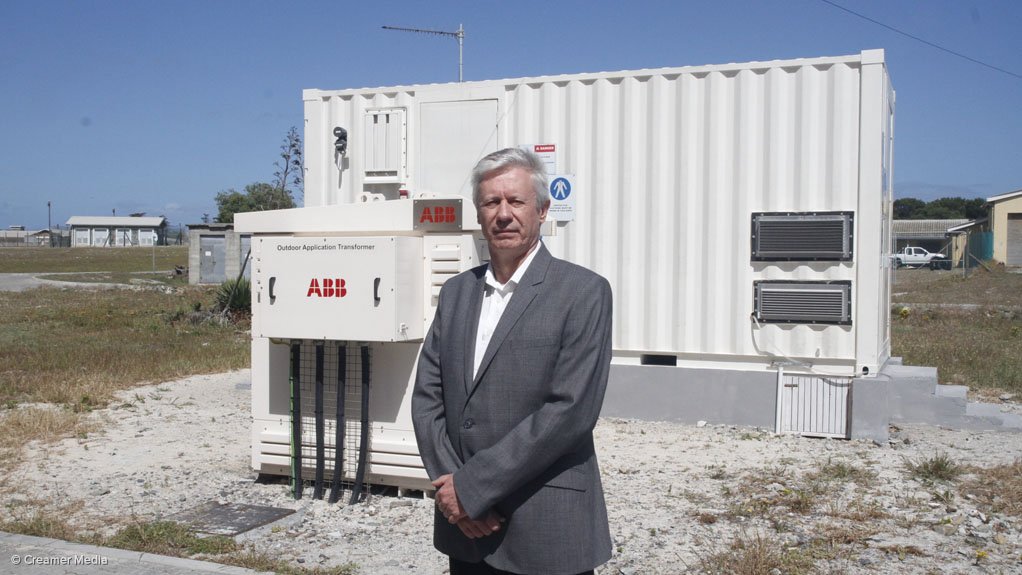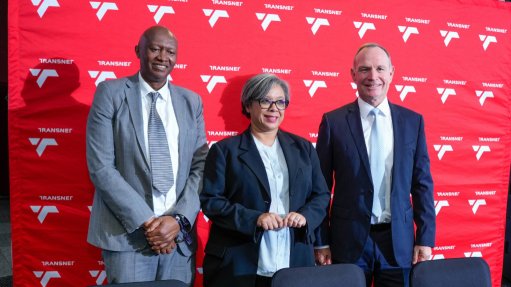Newly inaugurated PV microgrid to supply almost 50% of Robben Island’s electricity



LEON VILJOEN This system makes it the ideal solution, not only for the environment, but also from a business perspective
Photo by Duane Daws
SOLAR SUPPORT The solar photovoltaic farm comprises 1 960 monocrystalline modules with a total of 666.4 kW power supply
Photo by Duane Daws
Robben Island, a World Heritage Site, has gone green with the installation of a R25-million solar energy, lithium-ion battery storage microgrid that will supply almost half of the island’s yearly electricity requirement.
The Department of Tourism, together with the appointed engineering, procurement and construction (EPC) contractor, Sola Future Energy, and technology provider ABB officially inaugurated the microgrid last month.
Tourism Minister Tokozile Xasa handed over the microgrid to the Robben Island Museum as part of the department’s mandate to support sustainable and inclusive tourism development.
The microgrid is also part of a broader departmental pilot initiative implemented in collaboration with the management authorities of government-owned tourism attractions to retrofit facilities with solar energy generating systems.
“Preserving our environment and reducing our carbon footprint are critical to the sustainability of the tourism industry. The construction of the solar photovoltaic (PV) minigrid on Robben Island is a shining example of what can be achieved when government structures work together to preserve our ecological and cultural tourism assets for future generations,” the Minister noted.
She highlighted that the collaborative initiative not only affirms South Africa’s capability to engineer sustainable energy solutions but also “inspires hope that the business of tourism can be conducted in a sustainable manner”.
The solar energy system comprises a solar PV farm, a lithium-ion battery storage facility and smart controllers to ensure a seamless electricity supply and to enable the island to run on solar power for at least nine months of the year.
The island uses almost two-million kilowatt hours of electricity yearly for residential needs, as about 250 people live on the island.
Other power needs stem from the harbour and offices, as well as the desalination plant, which uses the bulk of the energy. The microgrid, however, will produce almost one-million kilowatt hours of electricity a year. The estimated payback for the microgrid is five years.
This will significantly reduce the island’s diesel use and the cost of buying and transporting the fossil fuel to the island, as well as reduce the costs of maintaining and servicing the six generators on the island, technology provider ABB South Africa and Southern Africa MD Leon Viljoen told Engineering News during a site visit last month.
The microgrid is expected to reduce the island’s fossil fuel consumption by half, or about 235 000 ℓ/y of diesel. The diesel generators will now primarily serve as backup power.
This will result in reducing the island’s carbon emissions by at least 820 t and will save the island money during its 25 years of operation.
EPC contractor Sola Future Energy was appointed by the Department of Tourism to design and build the microgrid for Robben Island.
Sola Future Energy design engineer Ian Burger explained during the site visit that the microgrid comprised three power production elements. The solar PV farm comprises 1 960 monocrystalline modules that supply a total of 666.4 kW.
The battery bank comprises 2 420 lithium-ion battery cells and is able to store 837 kWh and output a maximum of 500 kVA.
The microgrid on Robben Island is the largest combined solar and lithium-ion storage microgrid system in South Africa, said Sola CEO Dom Wills.
The third power production element is the diesel generators, which are used when no solar or battery storage is available. Multiple controllers between these power production elements balance the power supply and create a smart microgrid, thereby ensuring a seamless supply of power.
ABB supplied solar inverters that convert the variable direct current (dc) output from the solar panels into the alternating current (ac) required for electric utilities.
An ABB Ability wireless network will connect the solar plant to the microgrid and provide reliable and secure communications, while an operations centre in Cape Town will monitor and control the microgrid, Viljoen said.
He explained that the remote setup eliminates the need to maintain a workforce on the island, where volatile weather can sometimes impede travel to and from the mainland. The wireless solution has also eliminated the need for cable trenches, helping preserve the local habitat at the World Heritage Site.
ABB’s containerised, modular plug-and-play microgrid solution includes an ABB Ability PowerStore battery energy storage system and the dedicated Microgrid Plus control system with Internet cloud-based capabilities that make remote operation possible.
The control system enabled the management of the power supply, including energy storage and balancing of the use of renewable energy and diesel backup in accordance with changing demand, Viljoen told Engineering News.
“This system makes it the ideal solution, not only for the environment but also from a business perspective,” he emphasised.
ABB has installed about 40 microgrid installations around the world, across a diverse range of applications serving remote communities, islands, utilities and industrial campuses. The company is also pursuing further opportunities for microgrid installations across South Africa and Africa, Viljoen said.
Article Enquiry
Email Article
Save Article
Feedback
To advertise email advertising@creamermedia.co.za or click here
Comments
Announcements
What's On
Subscribe to improve your user experience...
Option 1 (equivalent of R125 a month):
Receive a weekly copy of Creamer Media's Engineering News & Mining Weekly magazine
(print copy for those in South Africa and e-magazine for those outside of South Africa)
Receive daily email newsletters
Access to full search results
Access archive of magazine back copies
Access to Projects in Progress
Access to ONE Research Report of your choice in PDF format
Option 2 (equivalent of R375 a month):
All benefits from Option 1
PLUS
Access to Creamer Media's Research Channel Africa for ALL Research Reports, in PDF format, on various industrial and mining sectors
including Electricity; Water; Energy Transition; Hydrogen; Roads, Rail and Ports; Coal; Gold; Platinum; Battery Metals; etc.
Already a subscriber?
Forgotten your password?
Receive weekly copy of Creamer Media's Engineering News & Mining Weekly magazine (print copy for those in South Africa and e-magazine for those outside of South Africa)
➕
Recieve daily email newsletters
➕
Access to full search results
➕
Access archive of magazine back copies
➕
Access to Projects in Progress
➕
Access to ONE Research Report of your choice in PDF format
RESEARCH CHANNEL AFRICA
R4500 (equivalent of R375 a month)
SUBSCRIBEAll benefits from Option 1
➕
Access to Creamer Media's Research Channel Africa for ALL Research Reports on various industrial and mining sectors, in PDF format, including on:
Electricity
➕
Water
➕
Energy Transition
➕
Hydrogen
➕
Roads, Rail and Ports
➕
Coal
➕
Gold
➕
Platinum
➕
Battery Metals
➕
etc.
Receive all benefits from Option 1 or Option 2 delivered to numerous people at your company
➕
Multiple User names and Passwords for simultaneous log-ins
➕
Intranet integration access to all in your organisation



















